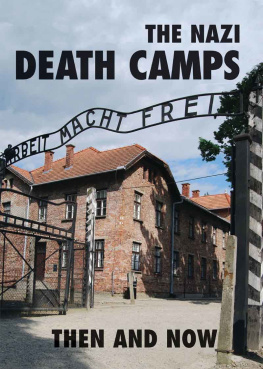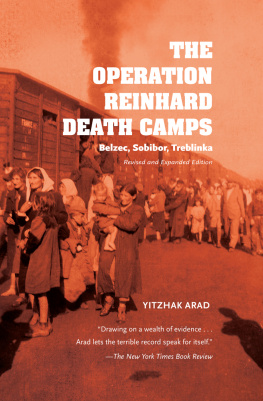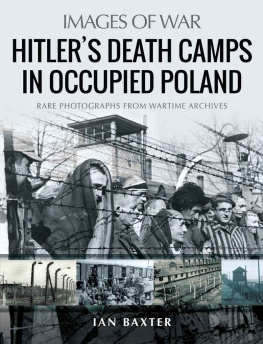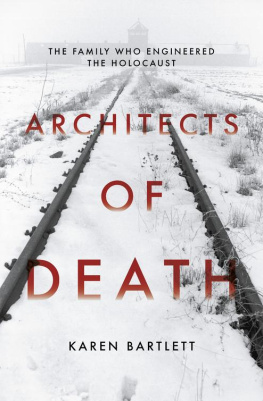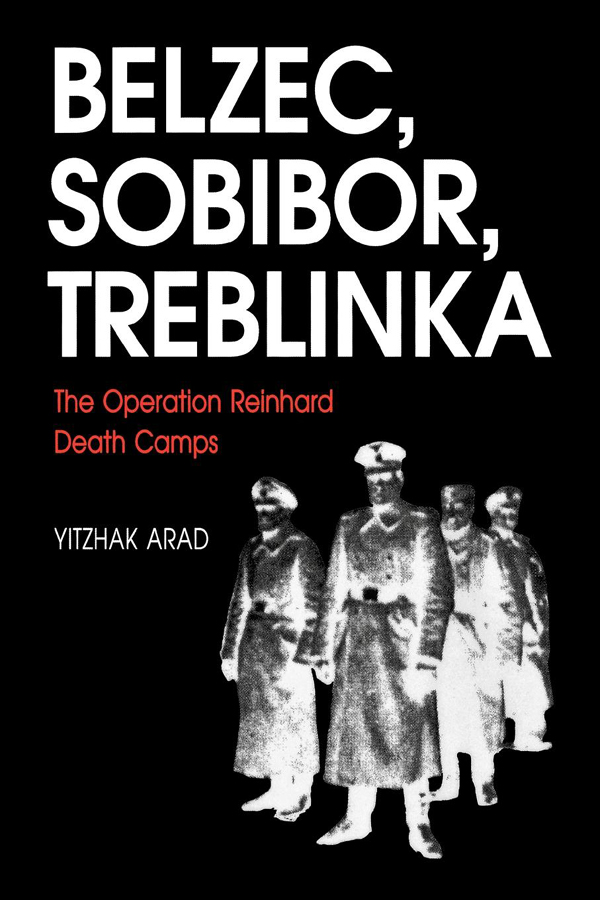BELZEC, SOBIBOR, TREBLINKA
YITZHAK ARAD
BELZEC, SOBIBOR, TREBLINKA
THE OPERATION REINHARD DEATH CAMPS
INDIANA UNIVERSITY PRESS
Bloomington and Indianapolis
This book is a publication of
Indiana University Press
601 North Morton Street
Bloomington, IN 47404-3797 USA
http://www.indiana.edu/~iupress
Telephone orders 800-842-6796
Fax orders 812-855-7931
E-mail orders
This work was made possible by a grant from the Memorial Foundation for Jewish Culture.
First reprinted in paperback in 1999.
1987 by Yitzhak Arad
All rights reserved
No part of this book may be reproduced or utilized in any form or by any means, electronic or mechanical, including photocopying and recording, or by any information storage and retrieval system, without permission in writing from the publisher. The Association of American University Presses Resolution on Permissions constitutes the only exception to this prohibition.
The paper used in this publication meets the minimum requirements of American National Standard for Information SciencesPermanence of Paper for Printed Library Materials, ANSI Z39.48-1984.
Manufactured in the United States of America
Library of Congress Cataloging-in-Publication Data
Arad, Yitzhak, 1926
Bibliography: p.
Includes index
1. Belzec (Poland : Concentration camp)
2. Sobibor (Poland : Concentration camp)
3. Treblinka (Poland : Concentration camp)
4. World War, 19391945Prisoners and prisons, German.
5. Holocaust, Jewish (19391945)
I. Title.
D805.P7Z727 1987 940.54'72'4304384 85-45883
ISBN 0-253-34293-7 (cloth : alk. paper)
ISBN 0-253-21305-3 (paper : alk. paper)
ISBN 978-0-253-34293-5 (cloth : alk. paper)
ISBN 978-0-253-21305-1 (paper : alk. paper)
12 13 14 15 13 12 11 10
CONTENTS
Preface
Concentration camps and death camps were an integral component of Nazi Germanys governing system and a tool for achieving its political aims. These camps were part of the so-called SS-State, headed by the Reichsfhrer of the SS, Heinrich Himmler. The concentration camps were spread all over Nazi-occupied Europe. They served as places of detention and torture, centers of forced labor, and instruments for the physical elimination of those elementsJews and non-Jews alikewhom Nazi Germany considered its political opponents. The death camps, all of them erected in Nazi-occupied Poland, served one purpose: the physical and total extermination of the Jewish people. The crimes, cruelties, and murders committed by Nazi Germany against the Jews reached their peak in these death camps, the last station for millions of men, women, and children whose only guilt was being Jewish.
There were five death camps: Auschwitz-Birkenau, Chelmno, Belzec, Sobibor, and Treblinka. Auschwitz-Birkenau was, simultaneously, also a concentration camp. This book is a study of the death camps of Belzec, Sobibor, and Treblinka, which were established to expedite Operation Reinhardthe extermination of the Jews who lived in the General Government of Poland. However, in addition to the Jews of Poland, Jews from Holland, France, Greece, Yugoslavia, Germany, Czechoslovakia, Austria, and the Soviet Union were also murdered in the three camps.
The book discusses primarily the tragic and cruel events that transpired within these camps; it relates the complete storyfrom the preparations for construction of the camps at the end of 1941 until their final razing in the autumn of 1943. The physical layout of the camps, the transports to the camps and the deaths they claimed, the process and technique of the extermination, the deeds of the SS men who commanded and activated the camps and of the Ukrainian guards, who made up the majority of the armed forces in the camps, are all fully described.
Moreover, the book tells the tale of the hundreds of thousands of victims who were brought for exterminationalthough their stay in the camps usually lasted no more than a few hoursfrom the time they disembarked onto the railway platform until their corpses were removed from the gas chambers, buried in mass graves, and later cremated.
In each camp, a few hundred Jews were removed from the transports to do the physical work involved in the extermination process, as well as some service jobs. Most survived for only a short time, from a few days to several months, and were ultimately murdered, as were those who were sent directly from the transports for extermination. The book describes the daily life and work of these Jews, their Underground organization, the revolts and escapes from the camps. The number of victims in each camp, grouped by location of residence on the eve of deportation, and the timetables for the transports and murder are also included.
Nazi criminals who served in these camps stood trial in West Germany. The trial of the SS men who had served in Belzec was held in Munich in January 1965. The primary defendant was Josef Oberhauser; there were six others. The trial of the SS men who had served in Sobibor was held in Hagen and lasted fifteen months, from September 1965 until December 1966. The leading defendant was Kurt Bolender; there were eleven others. The first Treblinka trial, at which ten of the SS men who served in the camp were brought to trial, among them Kurt Franz, the deputy commander, was held in Dsseldorf between October 1964 and August 1965. The second Treblinka trial, at which Franz Stangl, the commander of the camp, was tried, was also held in Dsseldorf, from September 1969 to December 1970. These verdicts appear as appendixes to this book.
At the time the paperback edition of this book was issued in 1999, the story of the Operation Reinhard death camps had not yet been finished or closed. In recent years the issue had come up repeatedly in denaturalization trials held in courts in the United States and Canada, mainly against Ukrainians, the so-called Trawniki men, who served as SS guards in the camps of Belzec, Sobibor, and Treblinka.
This book is the fruition of extensive research by the author on the camps of Belzec, Sobibor, and Treblinka. The primary sources were testimonies of survivors, German documents, Underground sources, testimonies by Poles and Germans, and German trial protocols. The research involved in the study of any topic concerning the Holocaust, and, above all, the extermination camps, is emotionally difficult for any historian, and especially for one who personally experienced those times. My parents, Chaya and Yisroel Moshe Rudnitski, died in Treblinka, and only luck and resourcefulness staved off the same fate from my sister Rachel and myself.
BELZEC, SOBIBOR, TREBLINKA
Introduction
The policy of Nazi Germany toward the Jews in the years 19331945which has been termed in the historiography of the period the Final Solution of the Jewish Question in Europewas overtly aimed at exterminating the Jewish people. This policy was rooted in the racist Nazi ideology espoused and promulgated by Germany during the rule of Hitler.
In this Nazi ideology, the Aryan race is the superior race, the master race, and the German nation, which embodies this race, fulfills the role of master nation; everything beautiful and useful in the world is the product of this race. On the opposite end of the racial continuum are the Jews, the root of all evil. All that is destructive and ugly in the world was introduced by them and from within them, and they embody all that is totally negative in humanity. The Jew is a sub-human, a germ that attempts to infect the pure German blood. An unending struggle transpires between these two races, and the outcome is to determine the fate of the world and humanity, for this is an uncompromising struggle for life or death. Only the destruction of the Jewish people can ensure the victory of Nazi Germany in this battle for the future. This ideology led to the death camps of Belzec, Sobibor, and Treblinka.


